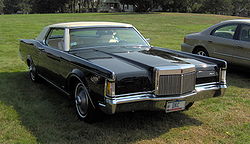- Lincoln Mark series
-
"Lincoln Mark" redirects here. For the pickup truck sold by Lincoln from 2005 to 2008, see Lincoln Mark LT.
Lincoln Mark Manufacturer Continental Division (1956–1957)
Mercury-Edsel-Lincoln (1958–1960)
Lincoln-Mercury (1968–1998)Production 1956–1960
1969–1998Assembly Wixom, Michigan Predecessor Lincoln Continental (1940–1948) Successor Lincoln LS Class Full-size personal luxury car Body style 2-door coupe
4-door sedan (1980–1983)Layout FR layout The Lincoln Mark series is a series of personal luxury cars that have served as the flagship of the Ford Motor Company product line. The series started in 1956 as the newly formed Continental Division introduced a successor to the original Lincoln Continental of 1940-1948. In 1958, the Mark series moved to Lincoln, where it was produced until 1960. In 1968, the Mark series was re-introduced as a personal luxury car, as the Lincoln Continental Mark III. In 1998, the discontinuation of the Mark VIII ended the series. The V8 version of the 2000 Lincoln LS was marketed as its replacement as the market for personal luxury coupes declined in the late 1990s.
Today, the influence of the Mark Series remains in the current Lincoln naming scheme. All models introduced since 2007 have adopted an "MK" alphanumeric prefix; the lone exceptions are the Navigator and the Town Car.
Contents
History
The Continental name was revived in 1955 as a separate Ford brand to produce the Continental Mark II. The new Continental was one of the most exclusive and expensive automobiles made at the time.
When Continental was merged with Lincoln in 1958 and the Lincoln Continental became the flagship model, the Mark continued to be sold as the Continental Mark. The Mark kept the Continental prefix until the introduction of a smaller Continental for 1982, becoming simply the Mark VII for 1984. The Mark VIII (1993–1998) was the last generation of the Mark and Lincoln's last personal luxury car.
Except for the 1958–1960 Continental Mark models and the 1980–1983 Mark VI 4-door sedan, the Marks were exclusively 2-door coupes.
Despite Continental's merging into Lincoln, the Marks (until Mark VII) were not identified as Lincolns except with the four-pointed star logo. The badges, identification plates, and factory paperwork do not bear the name "Lincoln". The rocker panels in the cars were stamped "Ford".[citation needed]
Mark II
Mark II 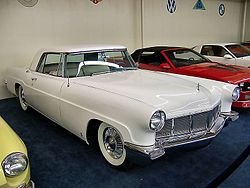
Production 1956–1957 Body style 2-door coupe Engine 368 cu in (6.0 L) V8 The Continental Mark II was a personal luxury car produced by a newly formed Continental Division of the Ford Motor Company for only two model years: 1956 and 1957.
The Mark II was available only as a two-door hardtop coupe. The new model eschewed chrome-laden styling of the period. Its understated design evoked a European simplicity of line. The Continental Mark II featured a Lincoln-style spare tire hump, shared the new 368 cu in (6.0 L) Lincoln Y-block V8 engine and running gear, and was sold and serviced at Lincoln dealerships. Four-door and convertible versions were explored by Ford, but not developed.
Most of the car was hand-built to high standards, including multiple coats of paint hand-sanded down, double-lacquered, and polished. The car's price was US$10,000 (US$80,811 in 2011 dollars[1]); was as much as a Rolls-Royce or two top-of-the-line Cadillacs at that time.
All Mark IIs were equipped with power steering, power brakes, power windows, automatic transmission, motorized radio and antenna, as well as a luxurious interior of imported Scottish leather. The only option available was air conditioning. The 1956 models had small "scoops" for air intake located on the upper rear fenders. Cool air from the trunk-mounted evaporator coil entered the passenger compartment from four vent registers located in the corners of the roof headliner.
Ford abolished the Continental Division at the end of the 1957 model year and the Mark III became a Lincoln.[2]
Mark III, IV and V (1958–1960)
Mark III, IV and V (1958–1960) 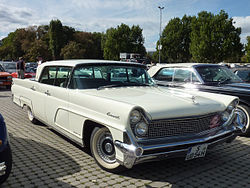
1959 Lincoln Continental Mark IVModel years 1958–1960 Assembly Wixom, Michigan, US Body style 2-door hardtop
2-door convertible
4-door sedan
4-door Landau hardtop
4-door Town Car sedan
4-door LimousineLayout FR layout Engine 430 cu in (7.0 L) MEL V8 Transmission 3-speed Turbo-Drive automatic Wheelbase 131.0 in (3,327 mm) Length 1958: 229.0 in (5,817 mm)
1959: 227.1 in (5,768 mm)
1960: 227.2 in (5,771 mm)Width 1958–59: 80.1 in (2,035 mm)
1960: 80.3 in (2,040 mm)Height 1958: 56.5 in (1,435 mm)
1959-60: 56.7 in (1,440 mm)Curb weight 5,000–5,700 lb (2,300–2,600 kg) Designer John Najjar After the Mark II was discontinued, a new generation of the brand appeared for 1958. These were the first Marks produced at the new Wixom plant, and were made on a unibody platform much like the original Continental. Though this edition is known as the "Mark III," the first models bore the nameplate "Continental III" on the front fender. While advertising brochures made the case that Continental was still a separate make, the car shared its body with that year's Lincoln. They differed from the lower-model full-size Lincolns in trim level and in their roof treatment, featuring a reverse-angle power rear "breezeway" window that retracted down behind the back seat. Hand assembly was gone, allowing for lower prices. Even so, Lincoln lost over $60 million during 1958-1960, partly reflecting the expense of developing one of the largest unibody cars ever made. The 1958 full-size Lincoln sold poorly in all models because the economic recession in the U.S. However, the Mark III recorded much better sales than the Mark II.
The new Lincoln was one of the largest cars ever made, larger than that year's Cadillac, and with their canted headlights and scalloped fenders had styling considered by many to be excessive even in that decade of styling excess. They were the longest and widest Lincolns ever produced without federally mandated 5 mph (8.0 km/h) bumpers. The 63.1 inches (1,603 mm) front and 63.0 inches (1,600 mm) rear shoulder room they possessed set a record for Lincoln that still stands to this day. Furthermore, the 1959 Mark IV and 1960 Mark V Limousines and Town Cars are the heaviest American sedans without an extended wheelbase built since WW II, and the 1958 Mark III convertible is the longest American convertible ever produced.
The 1959s range contained the original Mark IV, and the 1960, the original Mark V, with more restrained styling than the 1958. Two new body styles were added for 1959 and 1960, both on the same wheelbase as other Continentals, but without the reverse-angle "breezeway" window: a formal Town Car and an even more formal Limousine. Both cars had dual air conditioning units, a distinctive padded roof and were available only in black. The Limousine added a driver's partition for additional rear seat privacy. The Town Car cost over $9,200 with a total of 214 sold over both years, and the Limousine cost $10,200 with only a total of 83 sold, making it more expensive and perhaps even more exclusive than the Mark II.
One feature of these cars was the "Auto Lube", that, as long as the owner kept the lube reservoir full, the car automatically lubed itself. However, the 1958–1960 Marks were technically Lincolns as the Continental division was dropped after the Mark II. And this marked the last time that a Mark would share no major chassis components with a model made by Ford or Mercury as the next Mark III would share major components with the contemporaneous Ford Thunderbird.
Design Epilogue
The reputation for "excessive styling" is perhaps ironic given the enormous amount of styling talent that was connected with the development and modification of Marks of this vintage (as well as given the elaborate marketing efforts at eliminating all memory of these Marks). George Walker, known for his contribution to the development of the original Ford Thunderbird, was Vice-President in charge of Styling at Ford during this time. Elwood Engel, famous for being lead designer of generation four of the Lincoln Continental and for his work as chief designer at Chrysler in the 1960s, was Staff Stylist (and consequently roamed all of the design studios) at Ford during this period and worked very closely with John Najjar in developing not only the 1958, but also the 1959 update. After John Najjar was relieved of his responsibilities as Chief Stylist of Lincoln in 1957 he became Engel's executive assistant, and the two worked closely together in the "stiletto studio" in developing the fourth generation Lincoln Continental, which of course won an award for its superlative styling. After Engel left Ford in 1961, Najjar became the lead designer of the Ford Mustang I concept car, which later gave birth to the Ford Mustang. Don Delarossa, who succeeded Najjar as Chief Stylist of Lincoln, was responsible for the 1960 update, and went on to become chief designer at Chrysler in the 1980s. Alex Tremulis, who was Chief Stylist at Auburn-Cord-Deusenberg in the mid to late 1930s and famous for his work on the 1948 Tucker Sedan, was head of Ford's Advanced Styling Studio during this period, and it was his Ford La Tosca concept car, with its oval overlaid with an "X" theme, that gave birth to the "slant eyed monster" nickname to the 1958 Mark III front end. And, perhaps most ironic of all, L. David Ash was Lincoln's Executive Exterior Stylist when Najjar was in charge of Lincoln styling, the same L. David Ash who would later play such a prominent role as Chief Stylist of Ford in designing the 1969–1971 Lincoln Continental Mark III, which helped cause Marks of this vintage (together with a marketing decision by then Ford Executive Vice-President Lee Iacocca) to be called the "forgotten Marks".
Mark III (1969–1971)
Mark III (1969–1971) 
Production 1969–1971 Body style 2-door coupe Engine 460 cu in (7.5 L) V8 The Lincoln Continental Mark III was manufactured by Lincoln for model years 1969 through 1971. The Mark III was created when Iacocca, president of Ford Motor Company at the time, directed Design Vice President, Gene Bordinat, to "put a Rolls Royce grille on a Thunderbird" in September 1965. The Mark III was actually based on the four-door Thunderbird platform, which was first introduced for 1967.
The Mark III competed with Cadillac's front-wheel-drive Eldorado, which bowed for the 1967 model year and held the upper rung in the personal luxury car market. Introduced on April 5, 1968, as a 1969 model, the Continental Mark III outsold its Cadillac rival each model year.
The Mark III took many of its design cues from the mainstream Ford Thunderbird. Distinguishing features included a Rolls-Royce-like grille, hidden headlights, and a Continental spare tire hump in the decklid. The Mark III was one of the first vehicles to have power-controlled features and anti-lock brakes.
Differences for the 1969 model year included eight new exterior colors and an optional white leather/vinyl interior, as well as new headrests, steering wheel styling, instrument panel knobs, and color-keyed vinyl boots on the front seat belt anchors varied. A Cartier clock was introduced in December 1968. The non-Cartier clocks of the early cars have exhibited fewer problems than the Cartier-branded units.
The 1970 model year cars included the formerly optional vinyl roof and Sure-Track braking system. The interior wood trim was upgraded to genuine walnut wood trim (all 1969 models featured either East India Rosewood or English Oak wood appliques depending on the interior color). The Continental lettering on the decklid was bolted on (instead of glued on for 1969). The seat and door trim pattern was changed to a simpler design (instead of the diamond-pattern, button-tufted design of 1969). Also new were a locking steering column, rim-blow steering wheel, map light off delay device, concealed electric windshield wipers with adjustable intermittent feature, and a three-point restraint system for front outboard occupants.
The 1971 model year cars received radial tires, tinted windows, and an automatic climate control. High-back Twin Comfort lounge seats with two-way power controls were also new.
Mark IV (1972–1976)
Mark IV (1972–1976) 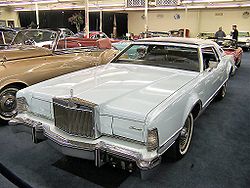
Production 1972–1976 Body style 2-door coupe Engine 460 cu in (7.5 L) V8 The Mark IV carried over many design themes of the Mark III, such as the grille and spare-tire hump, it grew both longer and wider as it shared the changes with the Ford Thunderbird platform. The 1972 models introduced the opera windows. The 1973 model year included new bumpers to comply with new US safety regulations that required all passenger cars to withstand a 5-mile-per-hour (8 km/h) front and a 2.5-mile-per-hour (4 km/h) rear impact.
In 1974, the rear bumper was also redesigned under mandatory federal safety regulations.
Mark IVs were powered by a 460 cu in (7.5 L) V8 engine.
Beginning in 1973 special Luxury Group packages were offered in various paint, roof, and interior color schemes from year to year. The Silver Luxury Group for 1973 included Silver "Moondust" metallic paint with a matching silver grained vinyl roof and a silver leather interior. Or, if the buyer preferred a unique color contrast, Cranberry (deep red) velour or leather interior trim was available. For 1974, a Gold Luxury Group and a Saddle & White Luxury Group (April 1974 introduction) joined the carryover Silver Luxury Group. For 1975, a Blue Diamond Luxury Group and a Lipstick & White Luxury Group joined the three carryover packages from the previous model year. For 1976, in addition to certain ones that carried over from the previous model year, Lincoln offered a dizzying array of new Luxury Group packages: Jade/White, Light Jade/Dark Jade, Red/Rose, Gold/Cream, Black Diamond (March 1976 introduction), and Desert Sand (March 1976 introduction). Lincoln continued to offer similar color-coordinating Luxury Group packages on the Mark V and Mark VI.
Mark V (1977–1979)
Mark V (1977–1979) 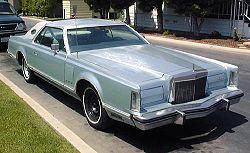
Production 1977–1979 Body style 2-door coupe Engine 460 cu in (7.5 L) V8 (1977-78)
400 cu in (6.6 L) V8 (1978-79)The large-sized Lincoln Continental Mark V was a restyled and updated version of the 1972–1976 models. The old Mark IV's more rounded styling was replaced with a more sharp-edged look. The new model no longer shared its platform with the Ford Thunderbird (which was downsized by shifting its nameplate to the smaller Mercury Cougar/Ford LTD II platform.) Interior design remained similar to the Mark IV, with variants in the seat patterns and dashboard trim (while retaining the general dashboard layout of the IV) being the primary differences.
The 460 cu in (7.5 L) of the Mark IV remained the standard engine of the Mark V for the 1977 model year.
In 1978, the Ford 400 cu in (6.6 L) Ford 335 engine engine replaced the 460 Ford 385 engine V8 as standard equipment, the latter available as an option everywhere but in California. The 460 V8 option was deleted entirely for 1979.
The Mark V was larger and more complex than its predecessor, coming just ten inches short of being 20 feet (6.1 m) long. The electrical system and mechanical componentry shared less in common with other Ford products, and was harder to service than the corresponding equipment on the Mark IV.
Mark VI
Main article: Lincoln Continental Mark VILincoln Mark series 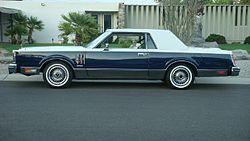
1980 Mark VI Bill Blass EditionProduction 1980–1983 Body style 2-door coupe
4-door sedanEngine 4.9 L (302 cu in) 5.0L Windsor V8
5.8 L (351 cu in) Windsor V8Transmission 4-speed AOD automatic Wheelbase 2-door: 114.3 in (2,903 mm)[3] Length 216.0 in (5,486 mm) Width 78.2 in (1,986 mm) Height 55.4 in (1,407 mm) The 1980 model year design revision and change to the Panther platform significantly reduced the size of the vehicle—the new model was 14 in (356 mm) shorter and rode on a wheelbase 6 in (152 mm) shorter than before—and the new car was 500 kilograms (1,102 lb) lighter. Aside from being the first Mark series available as a 4-door sedan in 20 years, the Mark VI retained most of the styling cues of the 1977 Mark V. The models retained the hallmark opera windows, Rolls-Royce style grille, and its characteristic vestigial spare-tire hump on the deck lid.
The Mark was available with Lincoln technology and electronic equipment. A digital instrument cluster using Vacuum Fluorescent Displays, pushbutton keyless entry, automatic overdrive (AOD) 4-speed automatic transmission, and a fuel injection on the 302 cu in (4.9 L) engine were new for 1980.
The new downsized Lincolns received positive reviews by the automotive press, being more efficient and more spacious than the corresponding Cadillacs of the same year that had been downsized for 1977. The new Lincolns used new assembly techniques, and had aluminum pieces in the body and mechanicals to lighten the cars, in addition to the 800 lb (363 kg) weight loss they received from the redesign. The old 460 cu in (7.5 L) V8 was replaced by a fuel-injected 302 cu in (4.9 L) V8 (marketed as a "5.0" model), and a carbureted version of the 351 cu in (5.8 L) V8, though the latter was available only for 1980.
The basic body was shared between Town Car and Mark VI, but the Mark bore more resemblance to the Mark V, with hidden headlamps, the spare tire bulge on the trunk, the vinyl top and opera windows, etc. For the last time, the Mark series was offered as a four-door sedan, but both Marks were dropped after 1983 in favor of a new Mark VII, and a small Continental sedan from 1982 to 1987 that was meant to replace Lincoln's unsuccessful Versailles mid-size. The Town Car and Town Coupe bore some resemblance to the old standard Continentals of the 1970s. A Town Coupe was available for both 1980 and 1981, but only about 3,000 were assembled during the two years. The success of the Mark VI effectively reduced interest in the Town Coupe. The Town Car continued to be Lincoln's bestseller for the rest of the 1980s.
The Mark VI was sold during a downturn in the U.S. automobile market. Total production of 2-doors over the four model years amounted to 63,662; or less than the Mark V in any one of its three years on the market.[citation needed] Part of the sales slump for the Mark VI was the redundancy after the Town Car; being for all intents and purposes the lower sedan with oval opera windows and concealed headlamps. Also the Mark V coupe, “from an appearance standpoint the car was essentially a scaled-down Mark V as most of the former’s styling elements were retained in the new design.”[4]
Mark VII
Mark VII 
Production 1984–1992 Body style 2-door coupe Platform Ford Fox platform Engine 302 cu in (4.9 L) Windsor V8
149 cu in (2.4 L) BMW M21 I6The Continental Mark VII, later just called the Mark VII, was introduced in 1984. It rode on the Ford Fox platform that was originally used by the 1978 Ford Fairmont and Mercury Zephyr. Mark VIIs was manufactured at the Wixom Assembly Plant in Wixom, Michigan through 1992.
The Mark VII had most of the comfort, convenience, and performance options that were available in the 1980s. This included all power accessories, leather seating, keyless entry, an onboard computer and message center, digital instruments (on all except the LSC models after 1986). All Mark VIIs came with full air suspension with an electronic ride control system. Mark VIIs also came with a 4-speed automatic transmission, stainless steel tubular headers, dual exhaust, and either a SEFI or throttle body fuel injection (dependent on model). Some 1987 models and all 1988 models also received a horsepower and torque boost thanks to a larger throttle body and better flowing cylinder heads.
The Mark VII was also the first American vehicle with electronic 4-channel anti-lock brakes (November 1984, six months before the Corvette). It was also the first American vehicle with composite headlights. The vehicle also featured a unique four-wheel air suspension that developed a problematic reputation.
The standard engine was Ford's 302 cu in (4.9 L) Windsor V8, equipped with fuel injection. A high-output version of this engine was available in the Mk VII LSC. The LSC model also included sport-tuned suspension and gearing. In 1984 and 1985 diesel version with BMW engine was available but it was rarely ordered.
Mark VIII
Mark VIII 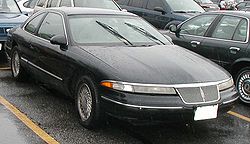
Production 1993–1998 Body style 2-door coupe Platform Ford FN10 platform Engine DOHC 4.6 L V8, 280 hp
DOHC 4.6 L V8, 290 hpRelated Ford Thunderbird
Mercury CougarThe Mark VIII was Lincoln's last personal luxury car, sold between 1993 and 1998. The Mark VIII was assembled at Ford's Wixom, Michigan assembly plant and was based on the FN10 platform. Slightly larger than the Mark VII, the Mark VIII had more interior space than its predecessor. The move from the Fox platform allowed for the use of fully independent suspension at all four wheels. Aside from its Ford and Mercury counterparts, the only other American rear-wheel drive cars at the time with this feature were the Chevrolet Corvette and Dodge Viper. The Mark VIII received a minor exterior redesign for the 1997 model year with a larger grille and exterior lights.
LSC
The 1996 LSC model got 10 hp (7.5 kW) more, true dual exhaust, lower (3.27) gearing and other luxury features. The 1996 LSC was the first car from an American automaker to be equipped with HID headlights, and the 1997 to 1998 models continued the groundbreaking lighting trend with even larger housings for the HID system, and an innovative neon third brakelight across the entire rear decklid.
Further use of name
MK9 and Mark X concept cars
In the early 2000s, Lincoln produced two personal-luxury concept cars using the Mark Series name. The two-door MK9 (pronounced "Mark Nine") debuted at the 2001 New York International Auto Show. Intended to explore the Mark Series past the discontinued Mark VIII, the MK9 was a two-door sedan with rear-wheel drive and a DOHC V8 engine[5] The styling of the MK9 influenced several later concepts, including the 2002 Continental concept and the 2003 Navicross.
In 2004, the last car to use the Mark Series name debuted at the Detroit Auto Show. The Mark X ("Mark Ten") was a two-seat convertible; a first for the Mark Series. Mechanically based on the 2002-2005 Ford Thunderbird, the Mark X added a power-folding retractable hardtop. Although its Thunderbird origins were apparent above the window line, much of the Mark X was restyled for a contemporary and modern appearance (rather than the retro styling seen on its Ford stablemate).
In a break from Mark Series tradition, the Continental spare-tire hump on the decklid was left out of the design of the two concept cars.
Mark LT (2005–2008)
After the discontinuation of the Blackwood after a single year of production in 2002, Lincoln stayed out of pickup truck market for three years. In 2005, the division tried again with the Lincoln Mark LT. As with the Blackwood, the Mark LT was based on the crew-cab version of the F-150; a major change from the Blackwood was the availability of all-wheel drive. After the 2008 model year, the Mark LT was rebadged as the Platinum trim level of the Ford F-150 in the United States and Canada, remaining for sale only in Mexico.
Lincoln MK naming scheme
During the 1990s, American luxury brands such as Lincoln lost market share to German and Japanese brands. As Lincoln and Cadillac began modernizing their lineups during the early 2000s, they both began to adopt alphanumeric naming schemes used by their competitors. At Lincoln, this started with the 2000 LS, which created some objections by Toyota, the owners of Lexus. As the LS and the Continental were both discontinued in the mid-2000s, the division introduced a new alphanumeric naming scheme that would partly revive the Mark Series. From 2007 to 2010, all newly introduced Lincolns would wear the "MK" (pronounced "emm kay") designation; the lone exceptions were the Town Car and the Navigator. The Zephyr was renamed the MKZ as part of a minor redesign, and the MKX was originally intended to be the second-generation Aviator. After the 2011 model year, the Navigator will become the sole non-MK Lincoln, as the Town Car is discontinued and its nameplate continues as the livery/limousine version of the MKT crossover.
References
- Inline
- ^ Consumer Price Index (estimate) 1800–2008. Federal Reserve Bank of Minneapolis. Retrieved December 7, 2010.
- ^ Bonsall, Thomas E. (2003). The Lincoln story: the postwar years. Stanford University Press. p. 64. ISBN 9780804749411. http://books.google.com/books?id=0s98D99c1tsC&pg=PA65&dq=Lincoln+Mark+II. Retrieved 5 January 2011.
- ^ 1981 Lincoln Continental promotional brochure, issued by manufacturer
- ^ Dammann, George (1987). The Cars of Lincoln Mercury. Crestline. p. 535. ISBN 9780912612263.
- ^ Vaughan, Daniel (December 2010). "2001 Lincoln MK9 Concept Images, Information, and History (Mark IX)". Conceptcarz.com. http://www.conceptcarz.com/vehicle/z3567/Lincoln-MK9-Concept.aspx. Retrieved April 16, 2011.
- General
- Flory, Jr., J. "Kelly" (2008). American Cars, 1946–1959: Every Model, Year by Year. McFarland & Company. ISBN 9780786432295.
- Flory, Jr., J. "Kelly" (2004). American Cars, 1960–1972: Every Model, Year by Year. McFarland & Company. ISBN 9780786412730.
Lincoln passenger vehicle timeline, 1922–1979 — next » Type 1920s 1930s 1940s 1950s 1960s 1970s 2 3 4 5 6 7 8 9 0 1 2 3 4 5 6 7 8 9 0 1 2 3 4 5 6 7 8 9 0 1 2 3 4 5 6 7 8 9 0 1 2 3 4 5 6 7 8 9 0 1 2 3 4 5 6 7 8 9 Entry-level luxury car Lincoln-Zephyr WWII Lido Versailles Full-size Capri Continental Continental Premiere L-Series K-Series H-Series Cosmopolitan Personal luxury car Mark III Mark IV Mark V Limousine Custom Continental Mark III–V Halo car Continental Continental Continental Mark II Continental Mark III–V « previous Lincoln, a luxury division of Ford Motor Company – road car timeline, 1980–present Type 1980s 1990s 2000s 2010s 0 1 2 3 4 5 6 7 8 9 0 1 2 3 4 5 6 7 8 9 0 1 2 3 4 5 6 7 8 9 0 1 2 Personal luxury car Mark VI Mark VII Mark VIII Mid-size Versailles Continental Continental Continental Zephyr/MKZ LS Full-size Continental MKS Town Car Town Car Town Car Mid-size SUV Aviator Full-size SUV Navigator Navigator Navigator Mid-size crossover MKX Full-size crossover MKT Pickup truck Blackwood Mark LT Categories:- Full-size vehicles
- Lincoln vehicles
- Coupes
- Rear wheel drive vehicles
- 1950s automobiles
- 1960s automobiles
- 1970s automobiles
- 1980s automobiles
- 1990s automobiles
- Lincoln Mark series
Wikimedia Foundation. 2010.

